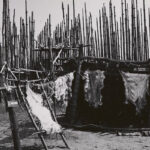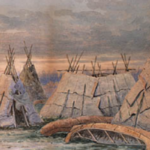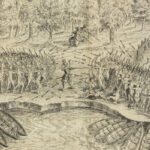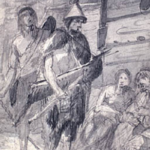Mohawk Council of Kahnawà:ke: A Legacy of Resilience and Cultural Continuity
The Mohawk Council of Kahnawà:ke, situated along the southern shore of the St. Lawrence River near Montreal, Quebec, represents one of the most significant communities of the Kanien’kehá:ka (Mohawk) people. As one of the original members of the Haudenosaunee Confederacy, Kahnawà:ke has played a pivotal role in shaping the history of North America. From its ancient origins through its interactions with European settlers and its development into a modern governance entity, Kahnawà:ke’s story is one of adaptability, cultural preservation, and resilience.
Pre-History: The Kanien’kehá:ka and the Haudenosaunee Confederacy
The Kanien’kehá:ka people, known as the “People of the Flint,” are one of the founding nations of the Haudenosaunee Confederacy (Iroquois Confederacy). The Confederacy, also called the Six Nations, originally included the Mohawk, Oneida, Onondaga, Cayuga, and Seneca, with the Tuscarora joining later. Established centuries before European contact, the Confederacy was governed by the Kaianere’kó:wa (Great Law of Peace), a sophisticated system of governance based on consensus, diplomacy, and balance.
The Mohawk occupied the easternmost territory of the Confederacy, acting as the “Keepers of the Eastern Door.” This position underscored their responsibility for safeguarding the eastern boundaries of Haudenosaunee lands and serving as intermediaries in trade and diplomacy.
The lands around the St. Lawrence River and the Mohawk Valley were central to the Kanien’kehá:ka way of life. These regions provided fertile grounds for agriculture, abundant game, and navigable waterways for trade and communication. Their communities thrived on the Three Sisters—corn, beans, and squash—while extensive hunting and fishing supplemented their diet.
Historian Barbara Graymont, in The Iroquois in the American Revolution, writes, “The Kanien’kehá:ka exemplified the strength and unity of the Haudenosaunee Confederacy, serving as both its warriors and diplomats in their interactions with neighbouring nations and later, European powers.”
First Contact with Europeans
European contact with the Kanien’kehá:ka began in the early 17th century, primarily through French explorers such as Samuel de Champlain and Jesuit missionaries. The French sought alliances with Indigenous nations to secure trade routes and counter the influence of British-aligned groups such as the Mohawk’s Haudenosaunee allies.
The arrival of Europeans brought both opportunities and challenges. The fur trade became a central aspect of early relationships, with the Kanien’kehá:ka trading beaver pelts for European goods such as firearms, metal tools, and textiles. However, these interactions also introduced devastating diseases like smallpox, which decimated Indigenous populations.
Jesuit missionaries established missions among the Mohawk, including Kahnawà:ke in 1667, named after the Mohawk word meaning “on the rapids.” This settlement near the Lachine Rapids became a focal point for Jesuit efforts to convert the Mohawk to Christianity. While some Kanien’kehá:ka adopted aspects of Christianity, many maintained their traditional beliefs, often blending the two in a unique syncretism.
Kahnawà:ke and the French
The French influence on Kahnawà:ke was significant in its early years. The mission settlement served as both a religious and strategic site. The Mohawk who moved to Kahnawà:ke often acted as intermediaries between the French and other Haudenosaunee nations. They maintained their autonomy while navigating the complex politics of the colonial era.
During the French and British conflicts of the 17th and 18th centuries, including the Seven Years’ War (1756–1763), the Kanien’kehá:ka of Kahnawà:ke often found themselves caught between competing empires. Their strategic location along the St. Lawrence River made them indispensable as allies, scouts, and warriors.
Relationships with the British
Following the British conquest of New France in 1763, Kahnawà:ke entered a new era of political and economic relations. While the British recognized the Kanien’kehá:ka’s strategic importance, the shifting dynamics of colonial expansion increasingly pressured their lands and autonomy.
The American Revolutionary War (1775–1783) brought further challenges. The Haudenosaunee Confederacy was divided in its allegiances, with some nations siding with the British and others supporting the American revolutionaries. The Kanien’kehá:ka of Kahnawà:ke largely aligned with the British, who promised to respect their lands and sovereignty in exchange for their support.
The Development of Kahnawà:ke
The 19th century brought significant changes to Kahnawà:ke. The construction of the Lachine Canal (1825) and the expansion of Montreal transformed the region, creating new economic opportunities but also intensifying pressures on Kanien’kehá:ka lands. Many members of Kahnawà:ke became involved in industries such as ironworking and construction, building a reputation as skilled labourers, particularly as ironworkers.
Despite the disruptions of colonial policies, including the imposition of the Indian Act (1876), the Kanien’kehá:ka of Kahnawà:ke maintained their cultural identity. The community resisted efforts to assimilate them into Euro-Canadian society, preserving their language, traditions, and governance systems.
The Role of the Mohawk Council of Kahnawà:ke
Established as part of the Indian Act’s system of band governance, the Mohawk Council of Kahnawà:ke became the administrative body for the community. While the Council operates within the framework of Canadian law, it has consistently sought to assert Kanien’kehá:ka sovereignty and self-determination.
The Council oversees education, healthcare, and infrastructure while advocating for the protection of Kahnawà:ke’s lands and resources. It also plays a central role in cultural preservation, supporting language programs, traditional ceremonies, and community events.
Cultural Resilience and Identity
Kahnawà:ke remains a vibrant centre of Kanien’kehá:ka culture. The community has invested in revitalizing the Kanien’kéha (Mohawk language), ensuring that it continues to be spoken by younger generations. Traditional practices, such as longhouse ceremonies and lacrosse—considered a sacred game—are integral to community life.
Annual events, including powwows and festivals, celebrate Kahnawà:ke’s heritage and provide opportunities for cultural exchange. These gatherings reinforce the pride and resilience of the Kanien’kehá:ka people, fostering unity and a sense of identity.
Kahnawà:ke Today
Today, Kahnawà:ke is a thriving community of approximately 8,000 members, balancing tradition with modernity. The Mohawk Council of Kahnawà:ke continues to advocate for the community’s rights, navigating the complexities of Canadian law while asserting Kanien’kehá:ka sovereignty.
The community has also become a leader in economic innovation, investing in renewable energy, technology, and tourism. These initiatives reflect Kahnawà:ke’s commitment to sustainability and self-determination.
Conclusion: A Legacy of Strength and Adaptation
The history of the Mohawk Council of Kahnawà:ke is a testament to the resilience and adaptability of the Kanien’kehá:ka people. From their ancient roots as Keepers of the Eastern Door to their pivotal role in the fur trade and their modern efforts in cultural revitalization, the Kanien’kehá:ka of Kahnawà:ke have maintained their identity and place within Canada’s evolving landscape.
As a centre of cultural preservation and political advocacy, Kahnawà:ke exemplifies the enduring strength of the Haudenosaunee Confederacy. The community’s story is one of perseverance, a reminder of the importance of honouring the past while building a sustainable future.
References
- Graymont, Barbara. The Iroquois in the American Revolution. Syracuse University Press, 1972.
- Trigger, Bruce G. The Children of Aataentsic: A History of the Huron People to 1660. McGill-Queen’s University Press, 1976.
- Conrad, Margaret. A Concise History of Canada. Cambridge University Press, 2012.
- Kahnawà:ke Cultural Centre. Keepers of the Eastern Door: The History and Culture of Kahnawà:ke. Kahnawà:ke Publications, 2015.
- Ridington, Robin. Trail to Heaven: Knowledge and Narrative in a Northern Native Community. Douglas & McIntyre, 1988.
- Williams, Dorothy. Treaties and Traditions: The Legacy of the Haudenosaunee. University of Toronto Press, 2009.
- Mohawk Council of Kahnawà:ke. Annual Report 2020-2021. Kahnawà:ke Governance Publications, 2021.
- Mann, Barbara Alice. Iroquoian Women: The Gantowisas. Peter Lang Publishing, 2000.
- Fenton, William N. The Great Law and the Longhouse: A Political History of the Iroquois Confederacy. University of Oklahoma Press, 1998.
- Wallace, Anthony F. C. Death and Rebirth of the Seneca. Vintage Books, 1972.



